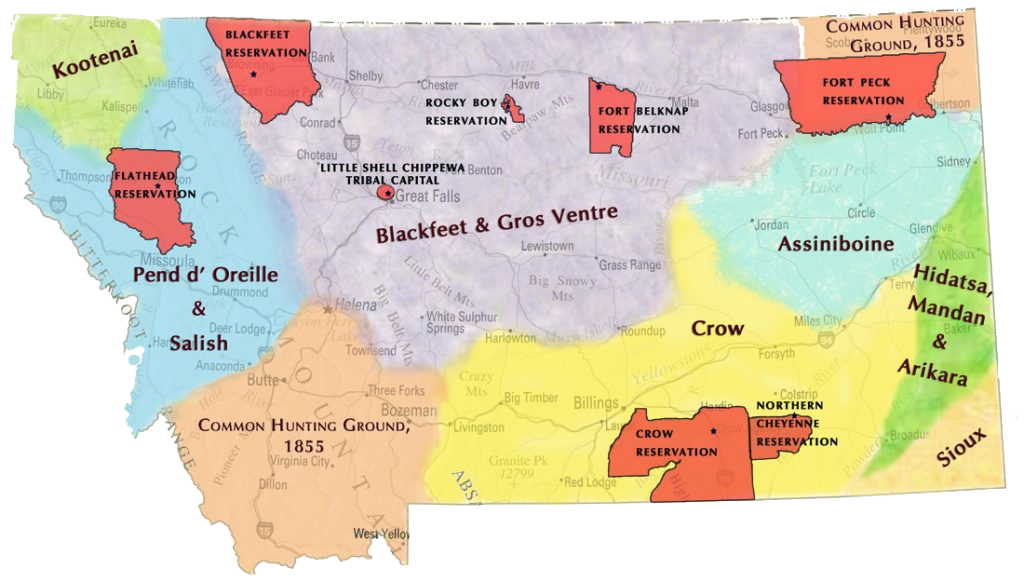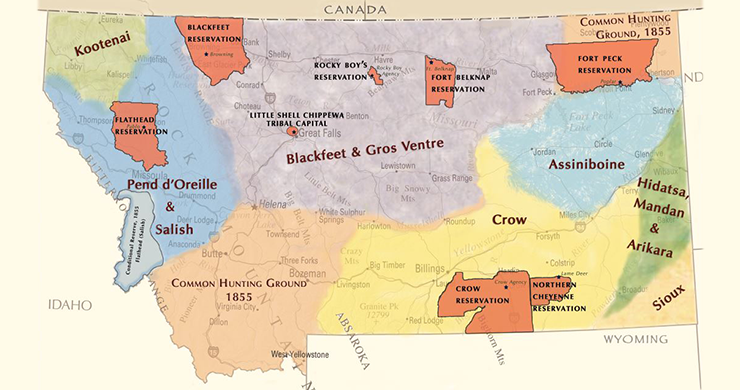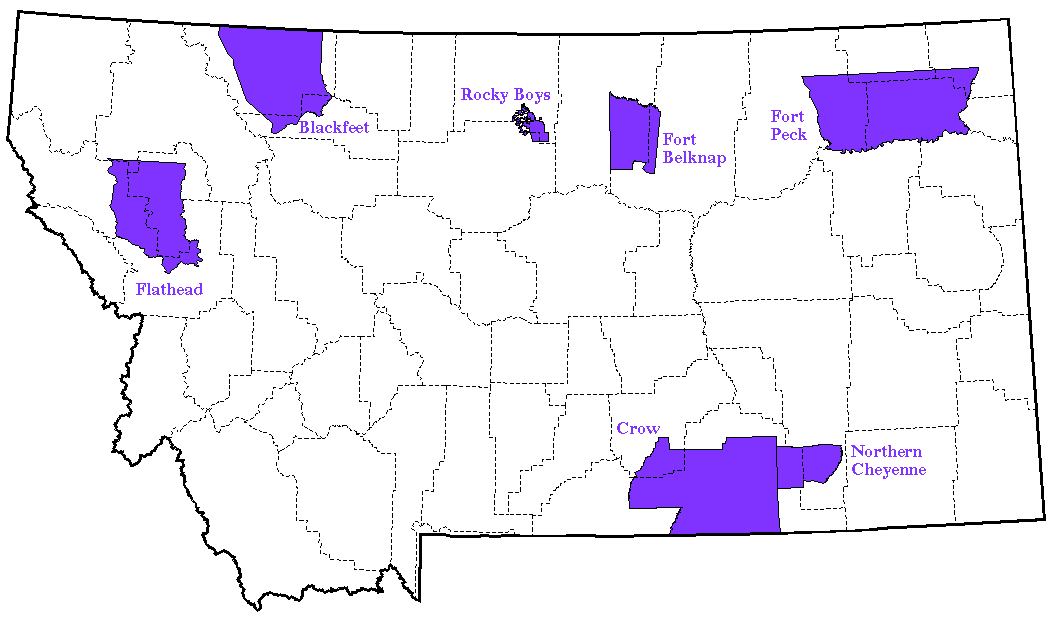Montana’s Tribal Territories: Unpacking the Map of Reservations
Montana’s Tribal Territories: Unpacking the Map of Reservations

Montana, the "Treasure State," boasts breathtaking landscapes, abundant wildlife, and a rich history. But beyond the stunning scenery and iconic mountains lies another important layer: the vibrant tapestry of Native American culture and history woven into the very fabric of the state.
Montana’s map is dotted with nine federally recognized reservations, each with its own unique story, traditions, and cultural heritage. Understanding these reservations and the people who call them home is crucial for appreciating the true complexity and depth of Montana’s identity. This article delves into the fascinating world of Montana’s reservations, exploring their history, culture, and the challenges they face today.
Related Articles: Montana’s Tribal Territories: Unpacking the Map of Reservations
- Uncover the Enchanting World of Indian Reservation Casinos in South Dakota
- Vegas Lights, Desert Dreams: Exploring The Moapa River Indian Reservation
- Where’s The Hampton’s Reservation? Unraveling The Myth Of A "Hamptons Indian Reservation"
- Texas Tribes: No Reservations, But A Rich Heritage
- Uncovering New York’s Hidden History: A Map Of Indigenous Tribes
A Journey Through Time: The History of Montana’s Reservations
The story of Montana’s reservations is a story of resilience, adaptation, and enduring spirit. Before the arrival of European settlers, the land that is now Montana was home to numerous Native American tribes, each with their own distinct language, customs, and way of life. The Blackfeet, Crow, Flathead, and Salish are just a few of the tribes that have called Montana home for centuries.
The arrival of European settlers in the 19th century brought about a dramatic shift in the lives of Montana’s Native Americans. The U.S. government, driven by a policy of westward expansion, forced tribes onto smaller and smaller plots of land, often through treaties that were later broken or misinterpreted. This led to the establishment of reservations, which were intended to confine Native Americans and assimilate them into American society.
The reservation system had a devastating impact on Native American culture and way of life. Traditional hunting grounds were lost, forcing tribes to rely on government assistance. The forced assimilation policies aimed to eradicate Native languages and customs, leading to a loss of cultural identity.
The Modern Landscape: Challenges and Triumphs
Despite the historical injustices they faced, Montana’s tribes have shown incredible resilience and have worked tirelessly to preserve their culture and traditions. Today, each reservation is a vibrant community with its own unique identity, offering a glimpse into the diverse tapestry of Native American life in Montana.
However, the challenges faced by Montana’s reservations remain significant. Poverty, unemployment, and lack of access to healthcare and education are persistent issues that many residents face. The legacy of broken treaties and government neglect continues to impact the lives of many Native Americans.
Navigating the Map: A Closer Look at Each Reservation

Let’s take a closer look at each of Montana’s nine federally recognized reservations:
1. The Blackfeet Nation:
- Location: Northwestern Montana, bordering Glacier National Park.
- History: The Blackfeet Nation, known for their skill as warriors and their strong connection to the land, were once a powerful tribe that controlled a vast territory. The Blackfeet Reservation was established in 1855 through a treaty that was later broken by the U.S. government.
- Culture: The Blackfeet Nation is known for its rich culture, including traditional ceremonies, dances, and storytelling. The Blackfeet language is still spoken by many members of the tribe.
- Challenges: The Blackfeet Nation faces challenges related to poverty, unemployment, and limited access to resources. The tribe is working to develop its economy through tourism and gaming.

2. The Crow Nation:
- Location: Southeastern Montana, near the Big Horn Mountains.
- History: The Crow Nation, renowned for their equestrian skills and their strong warrior culture, have resided in the Big Horn Mountains for centuries. Their reservation was established in 1868 through a treaty that promised them a vast territory.
- Culture: The Crow Nation is known for its vibrant culture, including traditional dances, ceremonies, and storytelling. The Crow language is still spoken by many members of the tribe.
- Challenges: The Crow Nation faces challenges related to poverty, unemployment, and limited access to healthcare. The tribe is working to develop its economy through energy development and tourism.

3. The Flathead Nation:
- Location: Western Montana, near Flathead Lake.
- History: The Flathead Nation, known for their peaceful nature and their strong connection to the land, have resided in the area around Flathead Lake for centuries. Their reservation was established in 1855 through a treaty that was later broken by the U.S. government.
- Culture: The Flathead Nation is known for its rich culture, including traditional ceremonies, dances, and storytelling. The Salish language is still spoken by many members of the tribe.
- Challenges: The Flathead Nation faces challenges related to poverty, unemployment, and limited access to resources. The tribe is working to develop its economy through tourism and gaming.
4. The Fort Belknap Indian Community:
- Location: North-central Montana, near the Missouri River.
- History: The Fort Belknap Indian Community is comprised of the Assiniboine and Gros Ventre tribes. Their reservation was established in 1888.
- Culture: The Fort Belknap Indian Community is known for its rich culture, including traditional ceremonies, dances, and storytelling. The Assiniboine and Gros Ventre languages are still spoken by some members of the tribe.
- Challenges: The Fort Belknap Indian Community faces challenges related to poverty, unemployment, and limited access to healthcare. The tribe is working to develop its economy through agriculture and tourism.
5. The Fort Peck Assiniboine and Sioux Tribes:
- Location: Northeastern Montana, near the Missouri River.
- History: The Fort Peck Assiniboine and Sioux Tribes have resided in the area for centuries. Their reservation was established in 1882.
- Culture: The Fort Peck Assiniboine and Sioux Tribes are known for their rich culture, including traditional ceremonies, dances, and storytelling. The Assiniboine and Lakota languages are still spoken by some members of the tribe.
- Challenges: The Fort Peck Assiniboine and Sioux Tribes face challenges related to poverty, unemployment, and limited access to healthcare. The tribe is working to develop its economy through energy development and tourism.
6. The Little Shell Tribe of Chippewa Indians of Montana:
- Location: Throughout Montana.
- History: The Little Shell Tribe of Chippewa Indians of Montana is a federally recognized tribe that has a long and complex history. The tribe was originally part of the Chippewa Nation but was forced to relocate to Montana in the 19th century. They were denied federal recognition for many years, but were finally recognized in 2019.
- Culture: The Little Shell Tribe of Chippewa Indians of Montana is known for its rich culture, including traditional ceremonies, dances, and storytelling. The Ojibwe language is still spoken by some members of the tribe.
- Challenges: The Little Shell Tribe of Chippewa Indians of Montana faces challenges related to poverty, unemployment, and limited access to healthcare. The tribe is working to develop its economy and build a stronger sense of community.
7. The Northern Cheyenne Tribe:
- Location: Southeastern Montana, near the Big Horn Mountains.
- History: The Northern Cheyenne Tribe is a powerful and proud tribe with a long and rich history. They were forced onto their reservation in 1877 after a series of conflicts with the U.S. government.
- Culture: The Northern Cheyenne Tribe is known for its vibrant culture, including traditional ceremonies, dances, and storytelling. The Cheyenne language is still spoken by many members of the tribe.
- Challenges: The Northern Cheyenne Tribe faces challenges related to poverty, unemployment, and limited access to healthcare. The tribe is working to develop its economy through tourism and gaming.
8. The Rocky Boy’s Indian Reservation:
- Location: North-central Montana, near the Missouri River.
- History: The Rocky Boy’s Indian Reservation is home to the Chippewa Cree Tribe. Their reservation was established in 1887.
- Culture: The Rocky Boy’s Indian Reservation is known for its rich culture, including traditional ceremonies, dances, and storytelling. The Chippewa Cree language is still spoken by some members of the tribe.
- Challenges: The Rocky Boy’s Indian Reservation faces challenges related to poverty, unemployment, and limited access to healthcare. The tribe is working to develop its economy through agriculture and tourism.
9. The Salish and Kootenai Tribes:
- Location: Western Montana, near Flathead Lake.
- History: The Salish and Kootenai Tribes have resided in the area around Flathead Lake for centuries. Their reservation was established in 1855 through a treaty that was later broken by the U.S. government.
- Culture: The Salish and Kootenai Tribes are known for their rich culture, including traditional ceremonies, dances, and storytelling. The Salish and Kootenai languages are still spoken by some members of the tribe.
- Challenges: The Salish and Kootenai Tribes face challenges related to poverty, unemployment, and limited access to resources. The tribe is working to develop its economy through tourism and gaming.
Beyond the Map: Understanding the Impact
Understanding Montana’s reservations is not just about geography. It’s about understanding the complex history, enduring culture, and persistent challenges faced by Native Americans in Montana. It’s about recognizing the vital role that tribal sovereignty plays in the future of the state.
The Future: Embracing Collaboration and Understanding
The future of Montana’s reservations depends on a shared commitment to understanding, collaboration, and respect. It requires recognizing the historical injustices faced by Native Americans, addressing the persistent challenges they face, and supporting their efforts to preserve their culture and traditions.
By embracing the stories and experiences of Montana’s reservations, we gain a deeper understanding of the state’s rich history and the diverse tapestry of cultures that make it unique.
FAQ: Unraveling the Mysteries of Montana’s Reservations
Q: How many reservations are there in Montana?
A: There are nine federally recognized reservations in Montana.
Q: What are the names of the reservations?
A: The reservations are:
- Blackfeet Nation
- Crow Nation
- Flathead Nation
- Fort Belknap Indian Community
- Fort Peck Assiniboine and Sioux Tribes
- Little Shell Tribe of Chippewa Indians of Montana
- Northern Cheyenne Tribe
- Rocky Boy’s Indian Reservation
- Salish and Kootenai Tribes
Q: What is the significance of the reservations?
A: Montana’s reservations are significant because they represent the vibrant culture, history, and resilience of Native Americans in the state. They also play a vital role in preserving traditional languages, customs, and ways of life.
Q: What are some of the challenges faced by Montana’s reservations?
A: The challenges faced by Montana’s reservations include poverty, unemployment, lack of access to healthcare and education, and the legacy of broken treaties and government neglect.
Q: What can I do to support Montana’s reservations?
A: You can support Montana’s reservations by:
- Learning about their history and culture
- Visiting reservations and supporting local businesses
- Donating to organizations that support Native American communities
- Advocating for policies that address the challenges faced by reservations
- Engaging in respectful dialogue with Native Americans about their experiences
Q: How can I learn more about Montana’s reservations?
A: You can learn more about Montana’s reservations by:
- Visiting tribal websites and museums
- Attending cultural events and festivals
- Reading books and articles about Native American history and culture
- Talking to Native Americans about their experiences
By embracing the stories and experiences of Montana’s reservations, we can all contribute to a more just and equitable future for Native Americans in the state.

Closure
Thus, we hope this article has provided valuable insights into Montana’s Tribal Territories: Unpacking the Map of Reservations. We thank you for taking the time to read this article. See you in our next article!